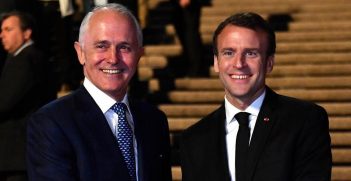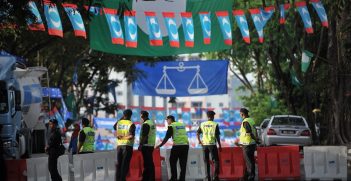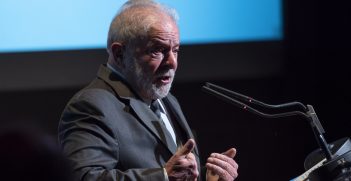Democracy on the Edge in Pakistan

What’s next in Pakistan politics? With democracy on the brink, and as an injured Imran Khan attempts to restore his political legitimacy, the race to form the next government promises upheaval.
Pakistan’s politics can be understood as a never-ending tussle between the military-bureaucratic elite and a political elite comprising political parties and their leaders over the governance of the state. The former has ensured its dominance over the latter directly (during periods of martial law) or indirectly (as the guardians of centrally controlled civilian regimes) by repressing political parties, cobbling together regime-friendly alliances through co-optation, rigging elections and interfering in candidate-selection, or limiting campaign activities.
Consequently, unbalanced civil-military relations have shaped the incentive structures of individual politicians—be they in the opposition or the government—to be short-sighted and willing to undercut each other by allying with the military to attain political power. They have sought access to state resources for the provision of patronage to their constituencies instead of shaping national policy.
Since 2008 the military has changed tack and moved away from direct intervention in politics. Instead, it has preferred to exercise its influence in the background by limiting civilian oversight or interference in its institutional interests, including promotions, appointments, and foreign policy. Moreover, the military has sought to control the national narrative to amplify its importance to Pakistan’s political stability.
The principal challenger to this status quo has been the Pakistan Tehreek-e-Insaaf (PTI) led by Imran Khan, which in 2011 became a viable third-party contender in Pakistan’s electoral politics. At the time, PTI’s rise was explained by the simplicity of Imran Khan’s populist, anti-American message that raged against the ineptitude and corruption of dynastic political elites. His charisma, carefully cultivated as captain of Pakistan’s cricket team, philanthropic works, and a spotless financial record gave credence to Khan’s aspirational message of a “Naya (new) Pakistan.”
Yet, PTI chose political expediency and compromised on its political message to win the 2018 election. Observers of Pakistani politicians found evidence to suggest that the military played the role of “king-maker” by working behind the scenes to remove the incumbent government under Nawaz Sharif’s PML-N (Pakistan Muslim League) and replace it with a more pliant and amenable party leadership. It was also noted that PTI’s success was dependent on the recruitment of so-called “electable” politicians who had a track record for winning elections, but were in fact, and contrary to PTI’s message, dynastic politicians who had been erstwhile allies of military regimes under Generals Zia ul Haq and Pervez Musharraf.
No matter how unprecedented and meteoric the rise of his party has been in the last decade, Khan’s tenure as prime minister has been less remarkable than expected and rife with issues of bad governance. He failed to improve the economy, with inflation rates rising precipitously and the IMF (International Monetary Fund) pulling funding away from Pakistan when Khan’s government proved unable to fulfil its commitments. Instead of building consensus in parliament, Khan’s preferred leadership style was to mobilize voters directly through rallies and street agitation. He attempted to pursue an independent foreign policy, which ostensibly led him to cozy up with Russia and China and drift away from the United States. However, the most egregious mistake that eventually led to Khan’s downfall was his assertion of civilian authority in the appointment of the Inter-services Intelligence Chief, which was perceived to be a direct impingement on the military’s institutional interests. As the rift between the military and its “hand-picked” prime minister widened, the opposition became emboldened to demand a vote of no-confidence against Khan. And here, PTI’s strategy to rely on so-called electable politicians to win key constituencies in 2018 also backfired. PTI accommodated politicians who defected from other political parties to contest on PTI’s ticket. As the no-confidence motion drew near, PTI was unable to hold its governing coalition together resulting in Khan being the first prime minister to be ousted by a no-confidence vote in Pakistan.
Since his ouster, Khan, backed into a corner, has once again taken to the streets to mount an unrelenting challenge to both the military and the new government led by PML-N’s Shahbaz Sharif. He has tapped into prevalent anti-American sentiment and garnered sympathy among his voters by vociferously claiming that his ouster was the result of a self-interested military colluding with the United States. He has also not let up on railing against Pakistan’s tried and tested political elites, making strong populist appeals to a predominantly disillusioned youth and urban support base. This political calculus is starting to pay off, as PTI has won 15 of the 20 seats that were up for by-election in Punjab. Moreover, the impressive turn out at PTI rallies in the heart of PML-N’s stronghold in Punjab is perhaps an indication of Imran Khan being well-positioned to win the next election as well.
Although, protest and agitation in an of itself is not negative, it is contributing to instability in a country where law enforcement agencies are institutionally weak. It also creates the perception of irreconcilable differences between the government and the opposition that can only be resolved through drastic action, such as regime change or direct intervention by the military. Finally, mobilising the masses purely through negative rhetoric and with no actual discussion of policy alternatives only serves to halt debate and hinder policy action on efforts that should be made to deal with flood relief and a dwindling economy.
The military’s response to Imran Khan’s rising popularity has resulted in the use of more overt tactics to achieve a favourable political outcome. These tactics are not new and once again seek to control the national narrative through the media. In August, antiterrorism charges were filed against Khan for remarks made against police officers and a judge. More recently, violence at the rallies, in particular open gunfire targeting Imran Khan, has led to the claim that the assailant was an ex-intelligence officer acting at the behest of a threatened military. These unfounded claims have created a tense political climate that does not bode well for Pakistan’s democracy as the military concurrently undergoes a leadership transition.
Mariam Mufti is an associate professor in Department of Political Science at the University of Waterloo, Canada.
This article is published under a Creative Commons License and may be republished with attribution.





